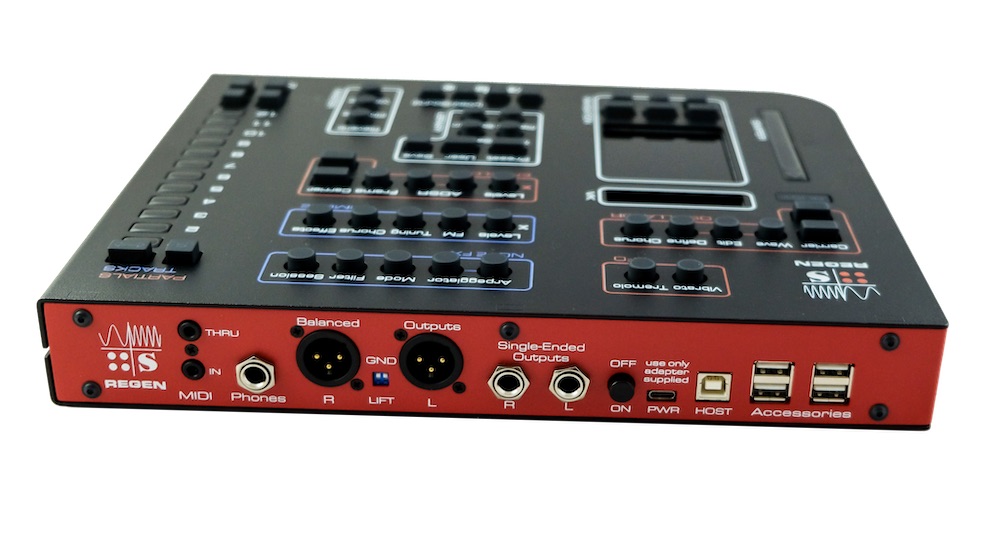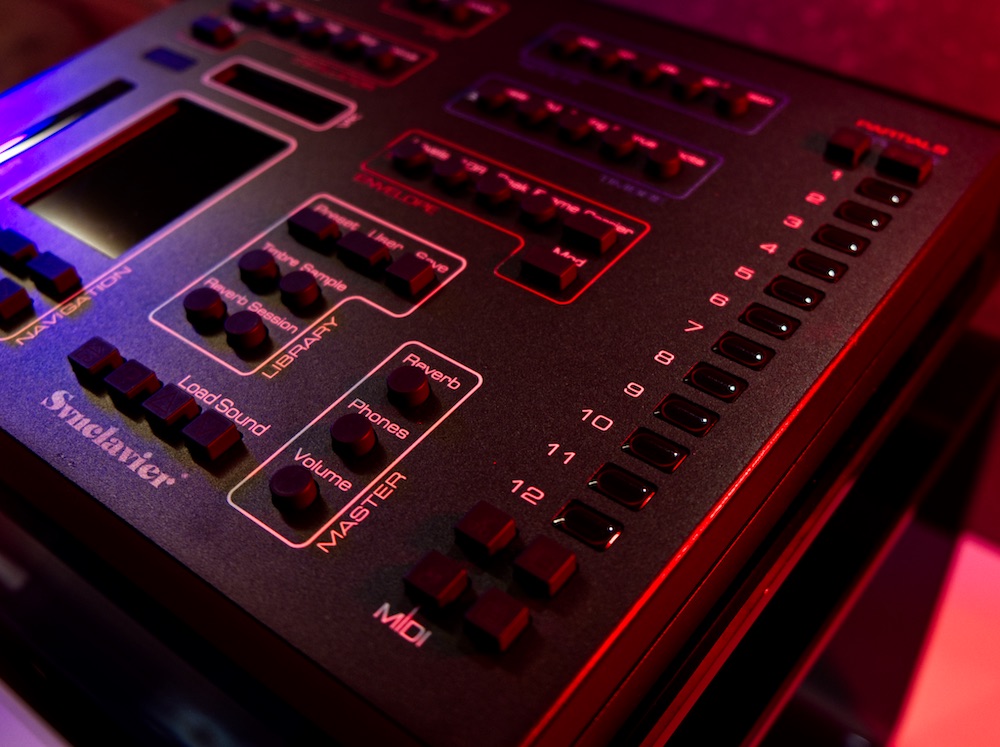A legendary name returns with this compelling premium synth. Greg Scarth finds out what makes it unique.

As the spiritual successor to one of the most iconic names in early digital synth history, the Synclavier Regen has a big reputation to live up to. Based mainly around FM synthesis but with elements of additive, wavetable and subtractive synthesis as well as sample playback and resynthesis involved, this is a serious synth with a focus on multitimbral layering of different tones to create unique sounds with a distinctively gritty character. But before we dig into the power of this latest incarnation, let’s take a look back at what makes the Synclavier name so special.
The history of the Synclavier starts in the mid 1970s, when a team at Dartmouth College in New Hampshire began working on what was then a wildly futuristic concept, developing a digital synthesiser. Launched in 1977 under the New England Digital brand name, the minicomputer-based Synclavier used FM synthesis to generate sound, but it was the development of the Synclavier II through the 1980s which really turned the device into a uniquely powerful – if still wildly expensive – instrument, offering multiple layers of uniquely crunchy-yet-musical FM sound, primitive sampling, sequencing and early forms of digital recording. The Synclavier genuinely did things which nothing else on the market could offer, and went on to be used by artists as diverse as Depeche Mode, Tangerine Dream, Frank Zappa, and Monolake’s Robert Henke, who restored his own Synclavier II and used it extensively on his Polygon Cities album.
As cheaper alternatives came to market, the life cycle of the pricey Synclavier machines gradually reached its natural conclusion by the early 90s, at which point the instrument was widely considered a hugely influential but sadly obsolete relic of history. At least, that is, until recent years, in which Cameron Warner Jones, one of the original developers of the Synclavier, bought back the rights to the name and released a mobile version, Synclavier Go!, and a virtual synth, Synclavier V, the latter in cooperation with Arturia. The Regen follows on from these software projects, directly linked back to the original, revolutionary instrument but updated for 21st century tastes, both in terms of user-friendliness and feature set.

What made the original Synclavier unique for the era was its digital approach, before mass market options like the Yamaha DX synths and E-mu Emulator samplers came to market. The Regen is based on the DSP synth engine of the early-80s Synclavier II, but makes a number of upgrades and updates to bring things kicking and screaming into the modern era. To understand how it all works, it’s easiest to start with the fact that sound settings are known as Timbres in Regen speak. Up to 12 Timbres can be active at any one time in a given Session, and each one can be set to respond to MIDI note signals in a number of ways. As they explain “Each MIDI note can play one or more of the active Timbres, or a blend. Incoming MIDI is routed to a Timbre using MIDI Channel numbers, a range of MIDI notes (for example a specific octave), or a combination. If all Timbres use a different MIDI Channel we call the Session a Mix. If all Timbres respond to the same MIDI Channel we call it a Stack. If some Timbres respond to a different note range, we call it a Split. Each Timbre in the session can be thought of as a Track or a Layer.” Timbres each consist of 12 Partials, which are essentially pairs of FM operators generated using a mixture of additive, subtractive or sample-based carriers and additive modulators. Complex? Yes, but stick with it…
What all of that adds up to is an undoubtedly complicated but immensely powerful synth engine which can do all sorts of different things, from the classic early 80s FM imitations of acoustic and electric instruments – similar but recognisably different to Yamaha DX sounds – through to more modern wavetable-style effects. The range of presets on offer displays the vast range of the Regen (well worth checking out in the video embedded above), with 550 Timbres spread across 10 libraries. Programming sounds from scratch is, of course, trickier than working from a preset and twisting it into your own sound, but it is doable with a little practice, especially when loading your own user samples from the SD card slot. Resynthesising samples is particularly powerful, analysing the harmonics of the sample over time, then regenerating them while allowing you to edit them additive-synthesis-style and blend them with the original sample. The appeal of vintage digital synths is perhaps harder to explain than that of vintage analogue instruments, but the Regen leans into it nicely, with a distinctive grit and character closer to an Emulator than a DX7 or any modern digital synth.

The Regen has depth unlike almost anything else on the market, and that’s reflected in its very unusual array of manuals, tutorials and help guides. However, given the complexity and numerous ways you can approach the synth, it’s reassuringly comprehensive. Begin with the printed Quickstart Guide in the box, best used in conjunction with the Signal Flow Block Diagram. From there, it’s probably easiest to go to the YouTube channel for a series of Quickstart Tutorial Videos, then once you’re up and running you can commit to the full PDF manual. At any given moment when using the Regen, a dedicated Help button on the front panel also activates advice and tool tips for the active page. It’s a slightly convoluted system of printed material, videos, documents and real-time help, but it does mean you can dip your toe into the basics first and then explore the more advanced features once you’ve learned your way around the powerful menu system of the instrument. All in all, the support’s there to help you understand the Regen, with further tutorial videos promised for more advanced features.

There are a few quirky things about the way the Regen works, perhaps most of all its interface. Synths are often praised for being ‘knobby’ – that is, having lots of knobs on the control panel – but the Regen is the exact opposite, without a single knob to be seen. Instead, it’s what you might call ‘buttony’, festooned with a grand total of 64 push buttons, including the 12 selector pads over on the right-hand side. The Swiper ribbon on the bottom left-hand corner, with its corresponding Nudge up and down pads, is the way parameters are adjusted once selected. There are occasional moments when the Regen’s menu-heavy workflow might make you wish for a bigger screen or even a touchscreen, but given that this is already an expensive synth at north of £2,000, we can understand why Synclavier had to draw the line somewhere to avoid costs spiralling out of control.
Ultimately, in the DAW era, one of the main objectives of a hardware digital synth is that it should offer something more cohesive and involving than a synth plug-in on a computer; after all, you could buy a decent laptop and plenty of plug-ins for the asking price here. For our money, the Regen hits the mark in that respect. You soon find yourself becoming comfortable with the two-handed approach, using your right hand primarily to select parameters and work your way through menus, then adjust parameters using the Swiper. The menu approach is clearly nothing to be ashamed of for Synclavier, and it works well enough thanks to the clear displays and logical approach. A positive side-effect is that there are no shift functions or hidden functions; everything relates nicely to the front panel buttons and well laid-out menu options.
As a result of that button-focussed front panel, the Regen isn’t a massively hands-on synth while you’re playing it, but one which allows you to dig deep into the sound layering power and set up complex patches and modulation routings, then perform them using a suitable controller. On that front, it’s well worth noting that the Regen is fully MPE compatible, so there’s huge scope to be had in routing the various dimensions of an MPE controller to synth parameters and exploring the real-time modulation options. (MPE-focussed preset Timbres are tagged in the menu system, allowing you to dive straight into the most relevant sounds.)

There are unique touches all over the Regen, from the curved corner of the metal case through to the ‘liquid-like’ feel of the Swiper. Ultimately, though, what makes it a singular instrument is that link to the history, character and sound of the Synclavier II. Maybe the history itself can’t be expressed through sound, but the sonic character of the Regen is undeniable. This is a synth with a distinctively retro-futuristic digital sound and the depth to keep you entertained for decades to come. Truly suitable for any genre or style of music, it’s a genuine all-rounder which follows its own path to create something very special. A classic reborn, effectively proving why this legendary name deserves respect.
Greg Scarth
More info/buy